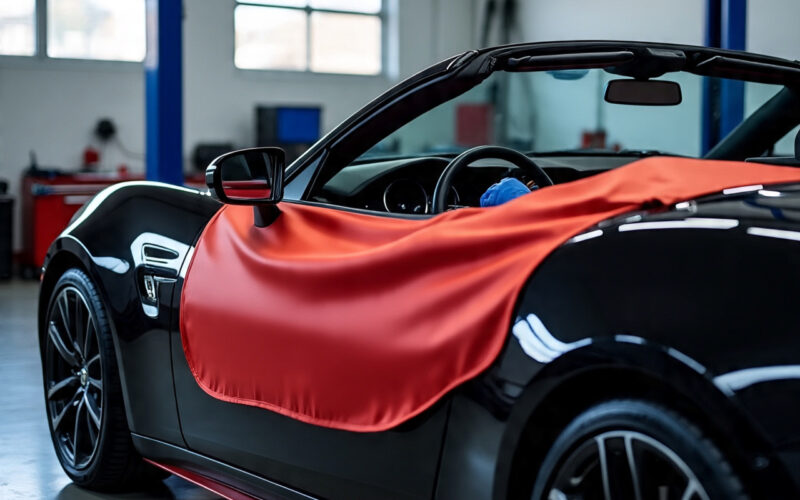Few things capture the spirit of open-road freedom like driving with the top down. A convertible is more than a car; it’s an experience. But behind that effortless drop-top lifestyle lies some important details every owner or future owner should know. From materials and mechanisms to care tips and seasonal prep, here’s a comprehensive guide to keeping your convertible top stylish, functional, and built to last.
The Basics: Materials That Define the Look
Canvas vs. Vinyl
When choosing or maintaining a convertible top, one of the first decisions comes down to material. Canvas tops, made from woven fabric, deliver a timeless look with better insulation and soundproofing. They breathe well, making year-round driving more comfortable. The downside? Without proper care, canvas can develop mildew, especially in humid climates.
Vinyl, by contrast, offers a sleeker, polished finish. It is easier to clean, naturally water-resistant, and lighter, which can even give your car a tiny performance edge. However, vinyl doesn’t breathe as well, so interiors may heat up quickly in summer. Prolonged sun exposure can also cause fading and cracks if not protected.
In the end, the choice comes down to lifestyle and environment. Canvas offers classic charm and comfort, while vinyl is low-maintenance and practical.
How They Work: Manual vs. Automatic Tops
Convertible tops operate in two main ways: manual or automatic.
Manual tops require you to unlatch and fold the roof yourself. They’re lighter, less likely to break, and generally cheaper to maintain. For purists, this hands-on method can even feel more connected to the car. But they’re less convenient, especially if a sudden rainstorm rolls in.
Automatic tops, on the other hand, use electric or hydraulic systems to lower or raise the roof with the push of a button. Many modern cars even add extras like sound insulation or remote operation. While convenient, automatic systems are heavier, more complex, and often pricier to repair if something fails.
When choosing between the two, consider how often you’ll use your convertible and how much value you place on convenience versus simplicity.
Picking the Right Top for Your Car
Not every convertible top fits every vehicle. OEM (Original Equipment Manufacturer) tops ensure a perfect match, while aftermarket versions may vary in fit and durability. Think about how you’ll use your car: weekend cruises may prioritize aesthetics, while daily driving calls for durability and ease of care.
Climate matters too. Hot, sunny areas demand UV protection, while rainy or snowy regions require strong waterproofing. Always ask about warranties and professional installation, since peace of mind is worth it.
Maintenance: Protecting Your Investment
Cleaning Essentials
For vinyl, mild soap, water, and a soft cloth are usually enough. A UV protectant adds an extra layer of defense against cracking and fading. Canvas needs more attention: specialized cleaners and waterproofing treatments keep mold and mildew at bay. Monthly cleaning is recommended, with quick touch-ups after bird droppings, sap, or heavy rain.
Protective Treatments
Canvas benefits from breathable waterproofing sprays, while vinyl should be treated regularly with UV protectants. These not only extend the life of the top but also keep it looking sharp. Professional detailing services can take things up a notch, though following product instructions carefully at home works too.
Common Issues
Leaks at seams, fading from UV exposure, mildew, and sluggish operation are the most frequent problems. Small leaks may be fixed with seam sealers, but larger issues usually need professional attention. Mechanical problems like fluid leaks or electrical faults should never be ignored. Early fixes save money down the road.
Seasonal Care: Year-Round Convertible Living
Summer Joy
Summer is convertible season. Before the heat hits, inspect and clean your top thoroughly. Use covers to protect against UV damage when parked. Driving early in the morning or evening avoids extreme heat, and interior sunshades help preserve upholstery.
Winter Protection
Cold weather is tougher on convertibles. Clean and treat your top before winter, and use a quality cover against snow and ice. Avoid lowering the roof in freezing conditions, which can strain the material and mechanisms. If possible, store your car indoors and run the top occasionally to keep parts lubricated.
Spring Refresh
After winter, give your convertible a full check-up. Inspect seams, zippers, and windows for wear, deep-clean the fabric or vinyl, and lubricate mechanical parts. A professional detailing session in spring can help restore both looks and function.
Customization: Making It Yours
Convertible tops aren’t just functional, they’re a style statement. Options range from classic black to bold colors or even patterned designs. Lighter shades reflect heat better, while darker ones add drama. You can also explore custom stitching, emblems, or even alternate materials for a more luxurious look.
Technology is bringing new upgrades too. Some tops now close automatically when rain is detected, while others can be controlled from your phone. Features like sound insulation and heated glass further enhance the driving experience.
DIY enthusiasts can also get hands-on with cleaning, protective treatments, or even installing small upgrades. Online communities and local car clubs offer endless inspiration and advice for those who love tinkering.
Final Thoughts
Owning a convertible means embracing a lifestyle of freedom and flair, but it also comes with responsibilities. The right material, mechanism, and care routine can make the difference between a car that turns heads for years and one that fades too soon. With thoughtful maintenance, smart upgrades, and seasonal prep, your convertible top will keep delivering open-air joy, season after season.




